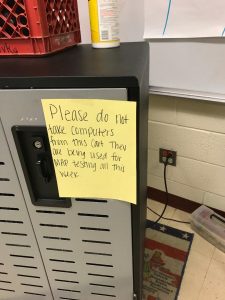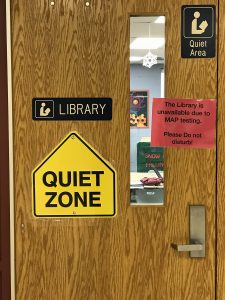The best thing about retirement is a sense of “done.” Done has a feel. Done has a texture. The cake is baked. Any zombies have been dismembered and burned. Done is not exactly burnt out – I still enjoy substitute teaching – but done means I can read in peace. I can write silly haikus about cooking shows or throw toffee on top of chocolate pudding pies. I can ignore the news freely and immerse myself in television shows I missed while grading, making spreadsheets, and trying to dig myself out of scary pedagogical corners. If I don’t tap the button that commits me to cover for another teacher, I can read through the middle of the night. I can turn off all the alarms.
I recommend life as a retired teacher. I recommend it especially to those working in urban and disadvantaged areas who are under constant pressure to hit impossible targets. On the one to ten scale, how stressed are you? That stress is not benign. Year after year of trying to do six impossible things before breakfast can leave you broken. Cardiovascular disease and PTSD happen even to teachers with fitness regimes.
Seriously, reader. On that one to ten scale, where are you? Are you getting near a natural breakpoint? Maybe you should find out where you stand in your state’s retirement scheme. Those later-life dollars often prove more vital than we expect, so I want to emphasize financial prudence here, but you also want to be in position to enjoy yourself when you move on to the next life-stage.
Looking back, I know I never minded the hard work I brought home, night after night, week-end after week-end. To those nonteacher readers who think teaching is an easy eight to three job with summers off, I’d like to say that someone grades all those math papers. When I did my student teaching, I discovered my cooperating teacher often stayed at her high school until 6:30 or later to get through the day’s papers. Grades must be entered in grading programs. Parent calls must be made. Emails must be answered. Meetings must be attended — before school, during school and after school. Assignments must be set up and sometimes printed. When still allowed, lessons must be planned, usually multiple versions for differing groups of students. Teachers can’t give the exact same lesson to one kid who is at grade level and another kid four years below grade level.
There’s a critical snippet of a line in the above paragraph: “When still allowed…” I kept going when my administration told me I had to give seventh-grade Common Core materials to my math classes, even though those classes were testing at an average third-grade level. I kept tutoring, even on week-ends at a McDonalds near my school, over half an hour from my home. I kept trying, and trying, and trying. But at some point, I changed. After years of telling myself, “You can do it!”, I found myself saying, “I can’t do this.” I would self-correct immediately at first. “I can too do it.” But I knew I did not believe myself.
I did not mind the work. But I did mind working stupid. My kids needed remediation that I was never allowed to provide in school and I could only get some of them to get up to get their Saturday breakfast tacos and math practice.
Eduhonesty: Are you being treated well, fellow teacher? All those hours, all that emotional investment in doing your best and doing the right thing? Do you feel appreciated? How are your self-messages sounding? Can you still say, “I can do it!” with confidence?
If your messages are beginning to sound shaky, if “can do” is being replaced with “can’t do” or even “It’s no use” or “Oh, man, what did I do this time?” – then maybe it’s time for a change. The exodus has already begun. According to the Wall Street Journal, in “the first 10 months of 2018, public educators quit at … the highest rate for public educators since such records began in 2001” — a number that translates to one million workers quitting public-education positions in 2018 according to Labor Department data. (Source: https://www.wsj.com/articles/teachers-quit-jobs-at-highest-rate-on-record-11545993052, Hackman and Morath)
I regret writing this post in some ways. Many of the teachers I know who recently retired or left the field were among the best teachers I knew – creative, engaged, and knowledgeable, with terrific classroom management skills. The tally of gifted, former educators who are now selling make-up and feminine care products ought to shake this country to its core.
But the economy has been on a roll. It’s an absolutely great time to be looking for a job. That includes a different teaching position if you love your work but don’t feel the love coming back from above. Those now-former educators leaving the field are peppering the internet with online vacancies.
If you are an older teacher who regularly feels unappreciated or even under threat, and if you are at a good break point in your state retirement plan, I recommend the smartest move I made all during that last, crazy year: I turned in the necessary forms to the state and I quit.
I didn’t sleep well last night, but that doesn’t matter. I made a delicious lactose-free, 1% latte, cut a sizable piece of pumpkin pie and sat down to my computers. I plan to join a friend for lunch at The Cracker Barrel. I’ll go to a book club later this week, not the one that I started. I will pull out the yarn for another crocheting project, my fourth or fifth, depending on whether wearability counts. I believe I am ready to graduate from scarves to a more complex shape than the classic rectangle. If all else fails, a monster Star Trek puzzle waits for me in the basement. I have been planning to get back to that puzzle for months now.
If your stress level is approaching ten then, please, reader, do yourself a huge favor: PUT YOURSELF FIRST FOR A CHANGE. Only you can decide if putting yourself first means changing employment or locations, or even retiring. I would like to encourage my stressed readers to take an afternoon or a day to make a “T” chart or a larger life map to explore the possibility of moving on. You are always one decision away from changing your life. Is it time for a change?






